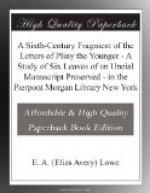Still further evidence is supplied by the external history of our manuscripts. B was at Beauvais at the end of the twelfth or the beginning of the thirteenth century, as we have seen.[43] Whatever the uncertainties as to its origin, any palaeographer would agree that it could hardly have been written before the middle of the ninth century or after the middle of the tenth. It was undoubtedly produced in France, as was F, its sister manuscript. The presumption is that _{Pi}_{1}, the copy intervening between _{Pi}_ and B, was also French, and that _{Pi}_ was in France when the copy was made from it. Merrill, for what reason I fail to see, suggested that the original of BF might be “Lombardic,” written in North Italy.[44] An extraneous origin of this sort must be proved from the character of the errors, such as spellings and the false resolution of abbreviations, made by BF. If no such signs can be adduced, it is natural to suppose that _{Pi}_{1} was of the same nationality and general tendencies as its copies B and F. This consideration helps out the possible evidence furnished by the scribbling in a hand of the Carolingian variety on fol. 53v;[45] we may now be more confident that it is French rather than Italian. But whatever the history of our book in the early Middle Ages, in the fifteenth century it was surely near Meaux, which is not far from Paris—about as far to the east as Beauvais is to the north. Now, granted for a moment that the last of our stemmata is correct, X, from which _{Pi}_ and B descend, being earlier than _{Pi}_, must have been a manuscript in majuscules, written in Italy, since that is unquestionably the provenience of _{Pi}_. There were, then, by this supposition, two ancient majuscule manuscripts of the Letters, most closely related in text—veritable twins, indeed—that travelled from Italy to France. One (X{1}) had arrived in the early Middle Ages and is the parent of B and F; the other (_{Pi}_) was probably there in the early Middle Ages, and surely was there in the fifteenth century. We can not deny this possibility, but, on the principle melius est per unum fieri quam per plura, we must not adopt it unless driven to it. The history of the transmission of Classical texts in the Carolingian period is against such a supposition.[46] Not many books of the age and quality of _{Pi}_ were floating about in France in the ninth century. There is nothing in the evidence presented by _{Pi}_ and B that drives us to assume the presence of two such codices. There is nothing in this evidence that does not fit the simpler supposition that BF descend directly from _{Pi}_. The burden of proof would appear to rest on those who assert the contrary. _{Pi}_, therefore, if the ancestor of B, contained at least as much as we find today in B. Some ancestor of B had all ten books. Aldus, whose text is closely




